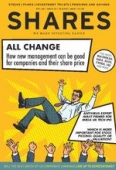Archived article
Please note that tax, investment, pension and ISA rules can change and the information and any views contained in this article may now be inaccurate.
Get ready for an important development with Chinese shares

With the war of words over tariff wars intensifying between the US and China, you may question the wisdom of investing in China at present.
However, from June index provider MSCI will begin to include 222 large cap China A-shares into its emerging market index as part of a two stage process, completing in September. That’s a very important development, as we now explain.
WHY DOES IT MATTER?
The Chinese government has been making efforts to open up its domestic equities markets to foreign investors for some time.
It has operated a quota system, the qualified foreign institutional investor programme (QFII), which allowed fund managers to invest in China’s capital markets.
The next development was the Hong Kong-Shanghai Connect in 2014 (followed by the Hong Kong-Shenzhen connect in 2016), allowing international and Chinese investors to trade securities in each other’s markets.
China is now also allowing foreign asset managers to set up shop in the country for the first time and tap their huge investment market. For the firms that have been awarded a wholly foreign owned enterprise (WFOE) licence, the products they launch are only available to Chinese investors.
However, a spokesman for asset manager Standard Life Aberdeen (SLA) says that being on the ground in China is a ‘combination of servicing the domestic client base and undertaking on-the-ground due diligence to invest in Chinese companies on behalf of our clients where ever they are based in the world’.
Last year, Aberdeen’s funds started making direct investments into China’s domestic equities, called ‘A-shares’. The country is now one of the asset manager’s biggest allocations, doubling its exposure in 2017.
Investors looking for exposure to Aberdeen’s China stock picks have a number of the company’s investment trusts at their disposal. These include the Aberdeen Asian Income Investment Trust (ASCI) for instance.
CAN YOU AFFORD TO IGNORE CHINA?
China has produced some real heavyweight companies, the BATs for instance (Baidu, Alibaba and Tencent). However, if investors want exposure to these companies, access to domestic A-shares is not required as they’re also listed on other exchanges including Hong Kong’s Hang Seng index, the New York Stock Exchange or traded in numerous places as American Depository Receipts.
Using Hong Kong is the main way Charlie Awdry, manager of Janus Henderson China Opportunities Fund (GB0031860934), plays China. His fund does have an allocation to A-shares and accesses these using the Hong Kong-Shanghai stock connect. The manager has a preference for large cap, mature cash generative businesses mostly found on the Shanghai index.
Other managers prefer the smaller companies found on the Shenzhen exchange. Tiffany Hsiao, manager of Matthew Asia China Small Companies (LU0721876364), says small cap Chinese companies are less volatile than their large cap peers and offer decent returns potential. One of her top picks, electrical appliances company Wuxi Little Swan, has returned 47.7% in a year.
ISN’T THE CHINESE MARKET VOLATILE?
Investors may still have the events of 2015 still in their minds, when the Shanghai Composite Index lost around 30% of its value in under a month. Such bouts of volatility, including the market being suspended twice on the opening day’s trading of 2016, may reasonably make investors reticent.
Another area of concern for those investors looking to China is that of corporate governance. Fortunately there are signs of improvement. Flavia Chong, head of Asia Pacific ex-Japan Equities at Aberdeen, says ‘while corporate governance standards still leave much to be desired, we have found notable exceptions’. Among these, Chong counts drinks company Kweichow Moutai and white goods-maker Midea.
Paul Jackson, head of multi-asset at Invesco Powershares, says foreign interest in A-shares, has mainly disappeared since the ‘rollercoaster ride of 2015’. However, he adds that with the inclusion of A-shares to the MSCI emerging market index coming up ‘investors will be obliged to take an interest and others may be encouraged to do so’.
MSCI estimated in June last year (when it first announced the plan to include A-shares) that the Chinese shares would only account for 0.7% of its emerging market index and just 0.1% of its All Country World index.
Due to the small weighting of A-shares, Jackson says their inclusion is unlikely to cause a ‘flood of money’. He does add that it’s an important ‘psychological step’ that could put the equities onto the radar of many international investors.
MSCI has also indicated that it may increase the number of A-shares at a later date as well as increase their weighting on the index.
HOW TO GET PASSIVE EXPOSURE
For investors seeking to gain more direct A-shares exposure through a passive product there are a plethora of products available. For example, Lyxor UCITS ETF CSI 300 A-Share (CSIA) is comprised of stocks from both the Shanghai and Shenzhen exchanges and adds to diversity.
For a more concentrated approach, DB X-trackers Harvest FTSE China A-H 50 UCITS ETF (AH50) reflects the performance of the top 50 companies in the Shanghai or Shenzhen index.
With many ways to access to the Chinese equities markets compared to just 10 years ago, it’s important to remember that the market is towards the top end of the risk spectrum.
David Hillier, head of multi-asset at Insight Investment, says ‘investing in China brings its own special risks because, as a centrally planned economy, there is always the risk that the government can enter or regulate markets in unexpected ways at short notice’.
Important information:
These articles are provided by Shares magazine which is published by AJ Bell Media, a part of AJ Bell. Shares is not written by AJ Bell.
Shares is provided for your general information and use and is not a personal recommendation to invest. It is not intended to be relied upon by you in making or not making any investment decisions. The investments referred to in these articles will not be suitable for all investors. If in doubt please seek appropriate independent financial advice.
Investors acting on the information in these articles do so at their own risk and AJ Bell Media and its staff do not accept liability for losses suffered by investors as a result of their investment decisions.
Issue contents
Big News
- JD Sports is still fighting fit
- ImmuPharma collapses on trial failure
- British Airways owner eyes takeover of Norwegian Air
- Apollo stalks FirstGroup with takeover interest
- Pound pushes to highest level since Brexit vote
- Cyber security firm Avast set for £2.8bn IPO
- Activist investor Elliott rumoured to have Micro Focus in its sights
- Costa spin-off calls at Whitbread gain momentum

 magazine
magazine









